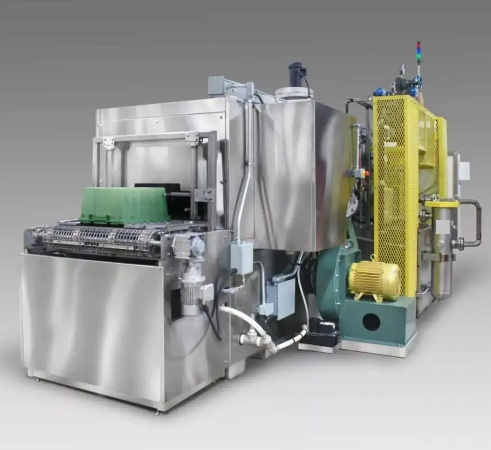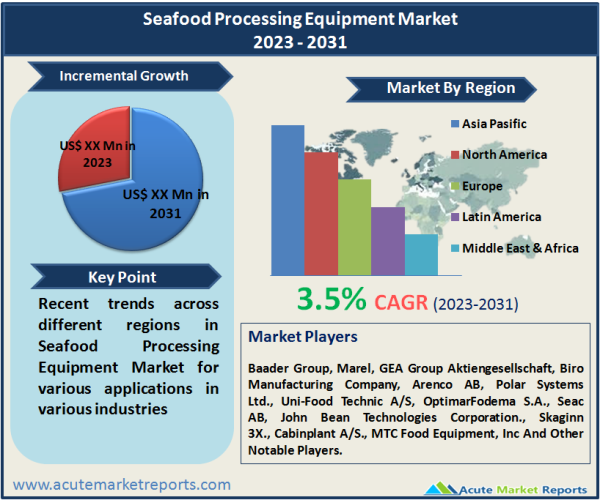
The seafood processing equipment market plays a vital role in the seafood industry, enabling the efficient handling and preparation of seafood products for consumption. The seafood processing equipment market is expected to grow at a CAGR of 3.5% during the forecast period of 2025 to 2033, driven by rising global seafood consumption, automation and technological advancements, and the globalization of seafood trade. However, environmental and sustainability concerns pose a significant challenge that the industry must address to ensure long-term sustainability. Market segmentation reveals the importance of equipment and product diversity, while geographic trends highlight the dominance of the Asia-Pacific region. The competitive landscape is marked by established leaders and innovative newcomers, all striving for innovation and market dominance. The market's future from 2025 to 2033 promises exciting developments and opportunities for the seafood industry and equipment manufacturers.

Rising Global Seafood Consumption
A major driver of the seafood processing equipment market is the ever-increasing global consumption of seafood. Seafood is a significant source of protein and essential nutrients for a growing world population. The demand for processed seafood, including frozen, smoked, canned, and dried products, has been consistently on the rise. This driver is supported by the trend of seafood being considered a healthier and more sustainable food choice.
Automation and Technological Advancements
Automation and technological advancements in seafood processing equipment have significantly driven the market. Automated machines and advanced equipment have improved processing efficiency, reduced labor costs, and enhanced product quality. In 2024, this driver was evident through the increased adoption of automated equipment such as filleting machines and scaling machines, which is expected to continue during the forecast period from 2025 to 2033.
Global Expansion of Seafood Trade
The global expansion of the seafood trade has led to an increased need for efficient processing equipment. Seafood is traded across borders more than ever before, and this international seafood supply chain relies on equipment capable of maintaining product quality during transportation and processing. This driver is supported by the ongoing globalization of the seafood industry and the need for consistent quality control.
Environmental and Sustainability Concerns
A significant restraint in the seafood processing equipment market is the growing concern for environmental and sustainability issues. The seafood industry is facing scrutiny regarding overfishing, habitat degradation, and seafood waste. This restraint is evidenced by consumer demands for sustainably sourced seafood and environmentally friendly processing practices. Equipment manufacturers and seafood processors must address these concerns by adopting sustainable practices and technologies to mitigate environmental impact.
Market Segmentation by Equipment: Filleting Equipment Dominate the Market
The seafood processing equipment market is segmented by equipment type, which includes Slaughtering, Gutting, Scaling, filling, and other specialized equipment for processes like shucking and peeling. In 2024, Flying equipment generated the highest revenue, while Scaling equipment exhibited the highest CAGR during the forecast period of 2025 to 2033. This segmentation emphasizes the importance of filleting and scaling processes in seafood processing and the industry's focus on automation in these areas.
Market Segmentation by Products: Frozen Seafood Products Dominate the Market
Further segmentation of the market is based on the types of seafood products, including Frozen, Smoked, Canned, Dried, and other specialized seafood products. In 2024, Frozen seafood products contributed the most substantial revenue, while Dried products displayed the highest CAGR during the forecast period of 2025 to 2033. This segmentation highlights the diverse preferences and the growth potential of different seafood product categories.
APAC Remains the Global Leader
Geographically, the seafood processing equipment market exhibits regional variations in trends. Asia-Pacific has been the region with the highest revenue in 2024, driven by the region's dominance in seafood production and export. North America and Europe have shown steady growth in seafood consumption and processing, emphasizing the importance of quality and efficient equipment. The Asia-Pacific region is also expected to have the highest CAGR during the forecast period, driven by the continuous expansion of the seafood industry.
New Market Entrants to Intensify Market Competition
The seafood processing equipment market's competitive landscape is characterized by intense competition among key players, including renowned companies such as Baader Group, Marel, GEA Group Aktiengesellschaft, Biro Manufacturing Company, Arenco AB, Polar Systems Ltd., Uni-Food Technic A/S, OptimarFodema S.A., Seac AB, John Bean Technologies Corporation., Skaginn 3X., Cabinplant A/S., MTC Food Equipment, Inc, and others. These companies have maintained their market leadership through continuous investment in research and development, product innovation, and strategic partnerships. In 2024, their revenues reflected their position in the market, and they are expected to continue their growth during the forecast period from 2025 to 2033. In addition to these major players, numerous emerging companies have entered the seafood processing equipment market, driven by the growing demand for efficient equipment. These newcomers are focused on developing cost-effective and specialized equipment to capture their share of the growing market. Partnerships and collaborations are key trends in the market, with established players working with seafood processors to implement equipment effectively. These partnerships aim to enhance processing efficiency and maintain product quality, ultimately benefiting both the industry and consumers.
Historical & Forecast Period
This study report represents analysis of each segment from 2023 to 2033 considering 2024 as the base year. Compounded Annual Growth Rate (CAGR) for each of the respective segments estimated for the forecast period of 2025 to 2033.
The current report comprises of quantitative market estimations for each micro market for every geographical region and qualitative market analysis such as micro and macro environment analysis, market trends, competitive intelligence, segment analysis, porters five force model, top winning strategies, top investment markets, emerging trends and technological analysis, case studies, strategic conclusions and recommendations and other key market insights.
Research Methodology
The complete research study was conducted in three phases, namely: secondary research, primary research, and expert panel review. key data point that enables the estimation of Seafood Processing Equipment market are as follows:
Market forecast was performed through proprietary software that analyzes various qualitative and quantitative factors. Growth rate and CAGR were estimated through intensive secondary and primary research. Data triangulation across various data points provides accuracy across various analyzed market segments in the report. Application of both top down and bottom-up approach for validation of market estimation assures logical, methodical and mathematical consistency of the quantitative data.
| ATTRIBUTE | DETAILS |
|---|---|
| Research Period | 2023-2033 |
| Base Year | 2024 |
| Forecast Period | 2025-2033 |
| Historical Year | 2023 |
| Unit | USD Million |
| Segmentation | |
Equipment Type
| |
Products
| |
|
Region Segment (2023-2033; US$ Million)
|
Key questions answered in this report